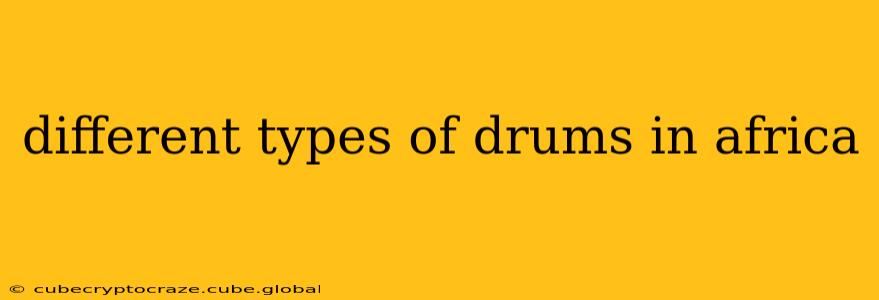Africa's rich musical heritage is deeply intertwined with its diverse drumming traditions. From the vibrant sounds of West Africa to the powerful rhythms of Southern Africa, drums are not merely instruments; they are integral parts of storytelling, ceremonies, and daily life. This exploration dives into the fascinating world of African drums, revealing the variety of forms and their cultural significance. Understanding these variations requires acknowledging the vast geographical and cultural landscape of the continent, where each drum type carries its unique story.
What are the main types of African drums?
This isn't a simple question with a simple answer! The sheer variety of drums across Africa makes categorization challenging. However, we can broadly group them based on construction, playing technique, and the sounds they produce. These include talking drums, cylindrical drums, goblet drums, hour-glass drums, and many more specialized regional variations. Each type has its own distinctive sound and role in the community.
What are talking drums and how do they work?
Talking drums, perhaps the most iconic African drums, are renowned for their ability to mimic human speech. This isn't literal speech, but rather the ability to produce tones and rhythms that convey meaning within a specific cultural context. These drums, often hourglass or cylindrical in shape, achieve this through a unique tensioning system. By adjusting the tension of the drumhead with the hands or arms, players can alter the pitch, creating a melodic conversation-like effect. Different communities have their own unique "dialects" in talking drum language.
What are some examples of different African drum types?
Let's explore some examples showcasing the diversity of African drumming:
-
Djembe (West Africa): This goblet-shaped drum, made from a hollowed-out tree trunk, is perhaps the most widely recognized African drum globally. Known for its deep bass tones and bright, crisp slaps, the djembe is used in a wide variety of musical genres and often played in ensembles.
-
Conga (Cuba, with origins in Africa): While now strongly associated with Cuban music, the conga's lineage traces back to African drums, particularly those of the Congo region. These tall, cylindrical drums produce a variety of sounds depending on where they are struck.
-
Dunun (West Africa): Often played alongside the djembe, dunun drums form the rhythmic backbone of many West African musical styles. These bass drums are larger than the djembe and produce deep, resonant tones. They are usually played with sticks.
-
Ngoni (East and Southern Africa): This is a family of drums, usually cylindrical or barrel-shaped, that are often used in traditional and contemporary music across East and Southern Africa. The specific design and sound vary considerably based on region and ethnicity.
-
Kendang (Southeast Asia, with African influences): While found in Southeast Asia, the kendang drum's lineage reveals strong connections to African drumming traditions. They feature a barrel-shaped body and are played with hands and sticks.
What are some of the materials used to make African drums?
The materials used to construct African drums are as diverse as the drums themselves. Common materials include:
-
Wood: Various hardwoods are used, chosen for their resonance and durability.
-
Animal hides: Goat, cow, or antelope skin are often used for drumheads, chosen for their tension and elasticity.
-
Rope/Vine: Used for tightening the drumheads.
-
Iron: Sometimes used as a decorative element and for reinforcement.
The specific materials used can vary based on regional availability and cultural traditions.
What is the cultural significance of African drums?
Beyond their musical role, African drums hold profound cultural significance. They are used in:
-
Religious ceremonies: Drums play a central role in many African religious rituals, marking important events and connecting with the spiritual realm.
-
Celebrations and festivals: Drums are indispensable during celebrations, adding to the festive atmosphere.
-
Storytelling and communication: As seen with talking drums, drums can narrate stories and transmit messages across distances.
-
Social cohesion: Group drumming fosters a sense of community and shared identity.
In essence, African drums are much more than instruments; they are living embodiments of culture, history, and community.
Conclusion
This exploration only scratches the surface of Africa's rich and diverse drumming traditions. Each region, each community, possesses its unique drumming styles, reflecting the continent's vibrant cultural tapestry. To truly appreciate the depth of African drumming, one needs to delve into the specific traditions of individual cultures, listening to their unique rhythms and understanding their profound cultural significance.
